新冠肺炎疫情近日再度復燃,東協各個經濟體受到程度不一的影響,許多國家必須重新實施管制,這也讓亞洲開發委員會(Asian Development Board)將原先對於東協的成長預測,從原先預期的4.4%調降至4.0%,短期內市場對於東協的投資意願也一如預料地轉差。不過,疫情並無法使東協的前景蒙上陰影,就長期面而言,東協的基本面仍然引人矚目。
東協十國擁有強大的經濟實力,國內生產毛額(GDP)合計達到2.6萬億兆美元1,是當前全球的第七大經濟體。到了2030年,東協更有望成為僅次於美國、中國及歐盟的全球第四大單一市場2。東協的另一大優勢是人口結構,東協人口約6.6億3,僅次於中國及印度,若以人口為計算標準,東協可謂全球第三大市場;更重要的是,東協在2040年的年齡中位數預計為35歲,相較同時期中國預計為47歲,日本預計為50歲4,勞動人口的不斷增長將是東協的未來優勢。
根據亞洲開發委員會預測,按照目前東協各國的疫苗接種進度,東協的經濟成長有望在2022年回升至5.2%。除了經濟成長外,東協的各項總體因素亦令人鼓舞。例如,相對溫和的通貨膨脹,整體通膨率及核心通膨率均呈下降趨勢(見圖1),而且商品價格的反彈並未帶動消費價格通膨廣泛上升。另外,由於通膨率大致都維持在東協各國的央行預期目標範圍內,央行得以延續寬鬆的貨幣政策立場,以支持疫情後的經濟復甦,甚而至於在有需要時,部分國家有空間進一步減息。
圖1:整體通膨保持溫和
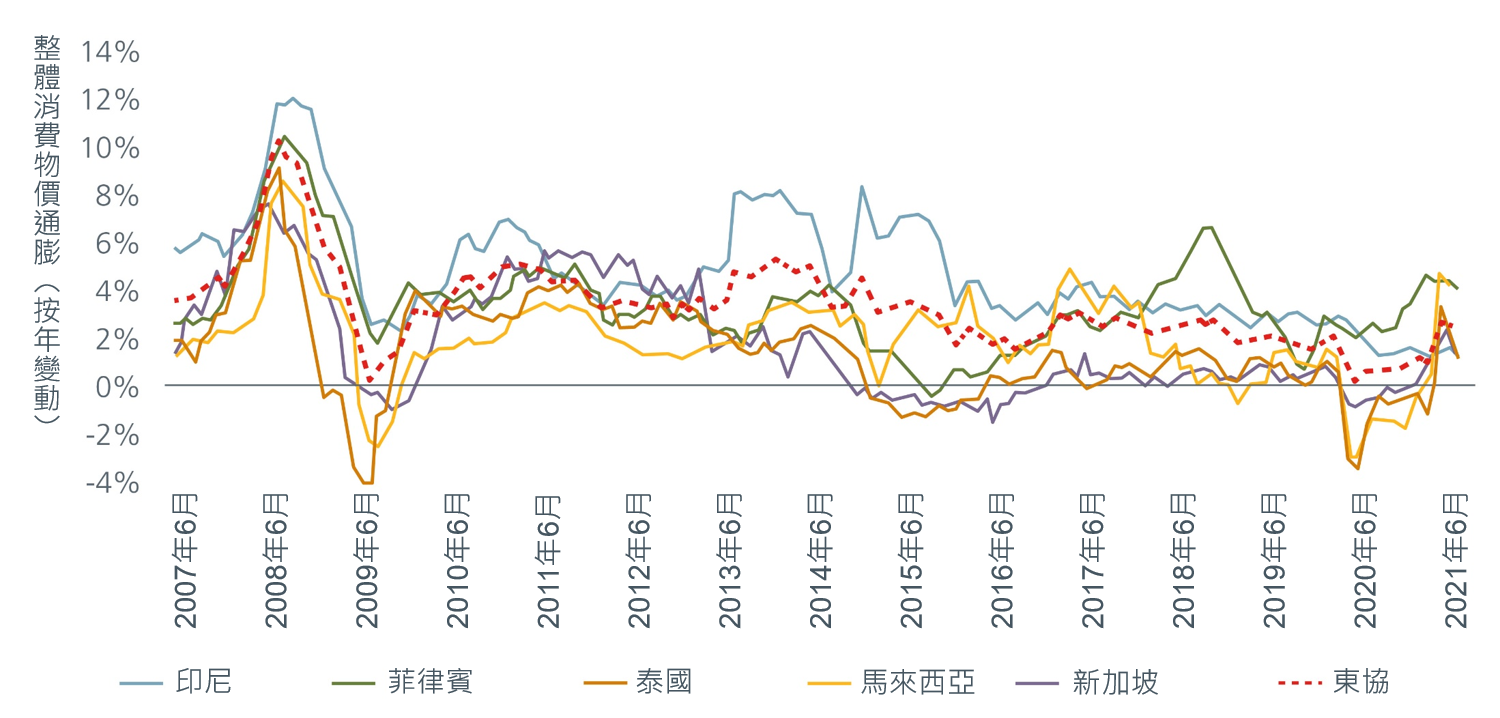
資料來源:瀚亞投資(新加坡)、BI、BSP、BoT、CEIC、Haver、摩根史坦利研究。數據截至2021年5月底或6月底。
另一個市場密切關注的指標是東協的國家外部結餘。從數據看來,東協的表現十分穩健︰東協五國(新加坡、馬來西亞、印尼、菲律賓及泰國)中,除印尼外,其餘國家的經常帳餘額佔國內生產毛額百分比均為正值(見圖2)。與此同時,國家的財政赤字正從2020年高位回落,但鑑於多國政府已經承諾在2021年增加支出以應對疫情,短期內財政赤字不太可能降至疫情前水準(見圖3)。;
圖2:大部分國家有穩健的外部結餘
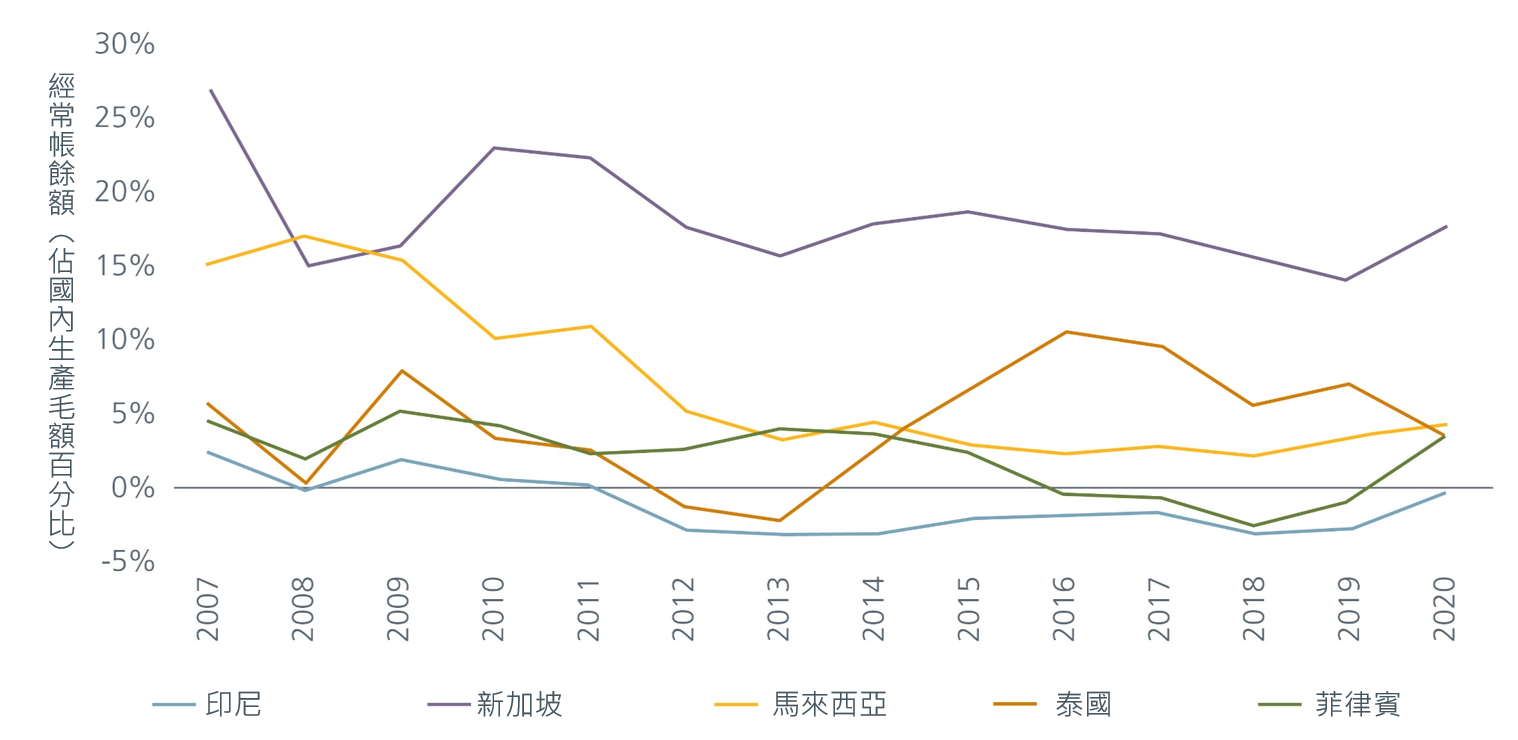
資料來源:瀚亞投資(新加坡)、CEIC、摩根史坦利研究。2020年最新整年度數據。
圖3:財政赤字從高位回落
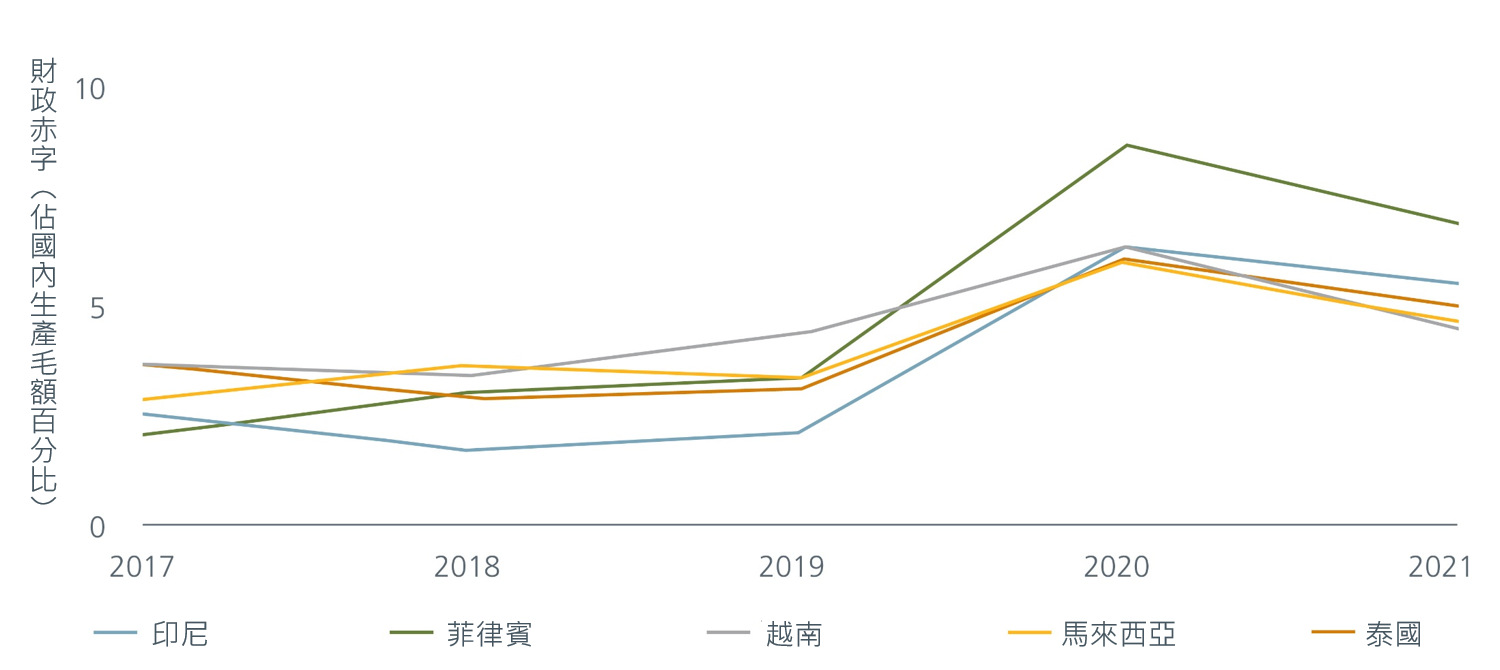
資料來源:llF、RaboResearch。
東協的戰略性位置造就其成為全球製造業及貿易往來的主要樞紐。因此,隨著已開發國家疫情趨緩,帶動經濟重新啟動,全球的貿易復甦對於東協而言非常有利。根據數據,東協五國的出口貿易不僅已經展現出復甦跡象,甚至還恢復至疫情前的水準(見圖4)。此外,由於美國為東協的貿易出口大國,占東協總出口百分比12%以上,美國對於商品需求的提升,亦有助於東協的經濟復甦。
同時,東協的製造業自今年初以來穩步向上,但6月進入萎縮區間5,並在7月開始下滑,這是因為東協多國為了因應趨於嚴重的疫情,決定實施更加嚴格的限制措施。不過,只要等到疫情穩定和限制措施陸續放寬,東協的經濟活動就會逐步回升至高於50的健康水準。製造業也將會在這波復甦中扮演重要角色。東協受益於各國間彼此不同的核心競爭力,整體東協擁有多元化的投資機會。同理,只有在東協各國完全解除疫情限制措施後,東協本身的國內消費力也會開始成為提高國內生產毛額的主要動力。
長期來看,我們認為東協的強勁成長將受益於這三大因素︰更大規模的區域整合、加速應用數位科技及更重視永續發展。
圖4:東協五國出口已恢復至疫情前水準
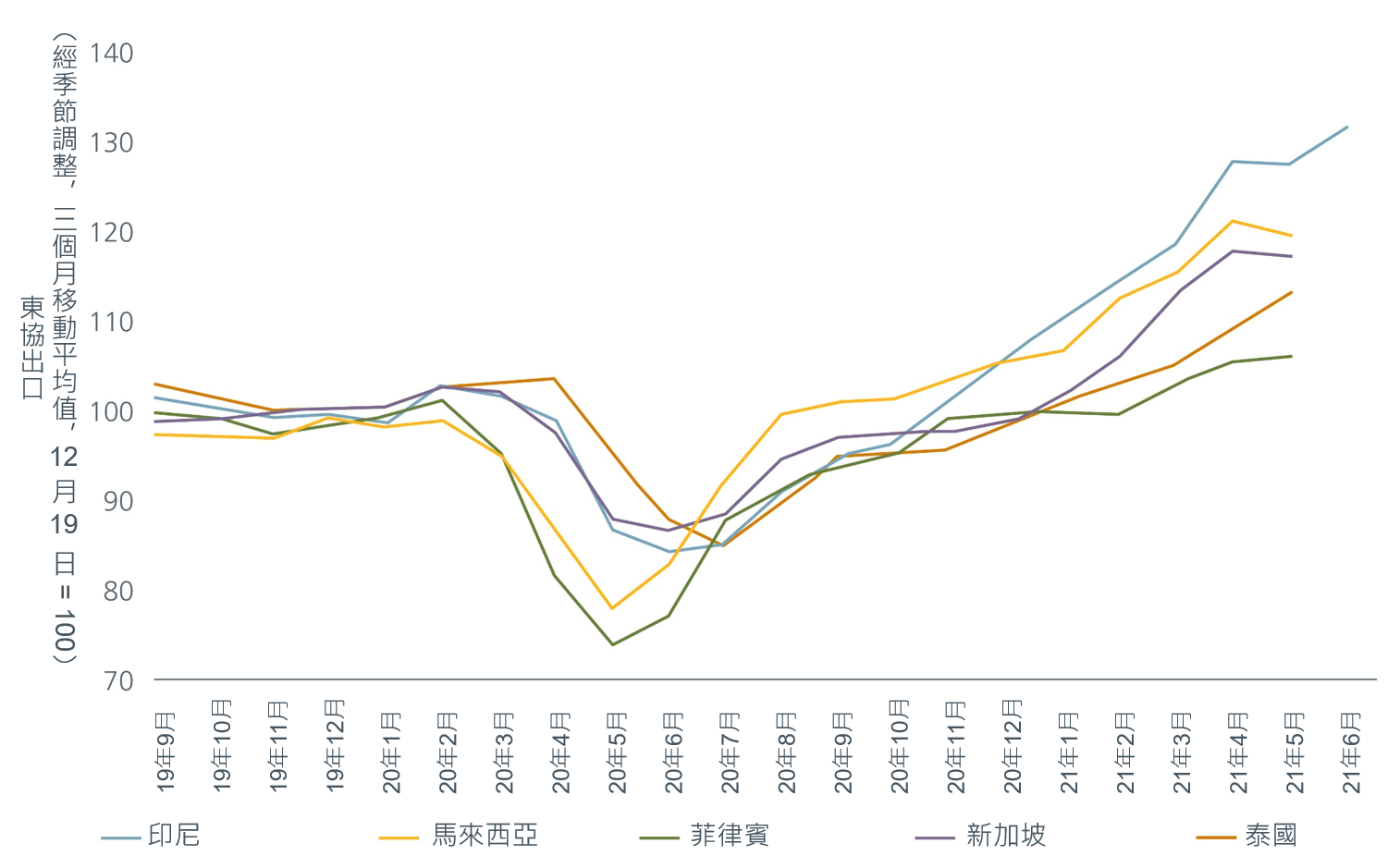
資料來源:瀚亞投資(新加坡)、CEIC、摩根史坦利研究。數據截至2021年5月31日,印尼數據截至2021年6月30日。
疫情促使東協推動區域整合,東協各國間以更緊密的合作關係,提升了整體競爭力。有賴於視訊會議,東協在疫情期間完成了歷時8年的加強貿易關係談判,終於在2020年11月簽署多項自由貿易協定﹙FTA﹚,包括區域全面經濟夥伴協定﹙RCEP﹚等龐大貿易協議。區域全面經濟夥伴協定的重要性不容小覷,因為該協定除了是東協與現有的貿易夥伴間的自由貿易協定外,若以國內生產毛額﹙GDP﹚為標準計算,區域全面經濟夥伴協定更是全世界最大的自由貿易協定,規模甚至大於跨太平洋夥伴全面進展協定﹙CPTPP﹚、歐盟﹙EU﹚、南美南方共同市場貿易集團﹙MERCOSUR﹚及美北自由貿易協定﹙USMCA﹚。
此外,由於全球正減少對於中國供應鏈生態系統的依賴,這對東協成員國的經濟成長及就業機會而言是利多消息。跨國公司有望在東協建立區域製造中心,用以整合東協的區域供應鏈生態系統。東協之所以是替代中國的理想區域有以下四點原因︰(1)部分東協成員國的製造業工資較低;(2)東協有鄰近中國的地理優勢,而中國在未來仍將保留大量供應鏈;(3)東協致力於建立單一市場及生產基地;(4)區域全面經濟夥伴協定將佔全球貿易約40%。6
東協的網路使用率持續倍增,人們漸漸習慣在手機上進行點擊,即可獲得商品、餐點、醫療服務、教育及娛樂。數位科技幾乎成為人們日常生活的必需品,這種因為疫情而加速轉型的新型教育型態,影響了企業及消費者的習慣。東協成員國正攜手努力,協助企業把握數位科技蓬勃發展帶來的機會。
由於疫情復燃而反覆實施的封鎖措施,除了促成新的上網習慣,更順勢推動電子商務的發展,使網路成為東協成長最快的經濟支柱。此外,東協各國正在研擬簽署東協電子商務協議,期待透過建立貿易規則與降低營運門檻,使倉庫配送系統及數據中心等實體基礎設施連帶受惠,也確保客戶擁有流暢的數位體驗。
網路經濟將保持穩健發展︰根據調查顯示,有高達94%的數位服務新消費者會在疫情後繼續使用各種數位服務。因此,東協將加大針對科技產業的投資,將資源集中到金融科技、醫療科技及教育科技。預計到2025年,東協的數位經濟估值將逾3,000億美元,是2020年僅僅1,000億美元的三倍之多。7
在促進經濟活動以及創造就業機會上,基礎建設的投資舉足輕重。新冠肺炎疫情凸顯東協在醫療、電訊及物流相關基礎建設的缺乏,東協各國政府除了正緊急填補該缺口外,也積極在升級改善其他領域的建設。根據亞洲開發委員會表示,由於東協的發展快速,東協每年需要投入2,100億美元的資金,才可以配合該區所設立的發展目標及未來氣候變遷帶來的挑戰。
可再生能源、物流及運輸、公共衛生及資訊通訊科技等,是東協基礎建設的優先發展項目,東協也具有成為綠色基礎設施的樞紐的潛力。東協需要進行能源轉型,目前東協的可再生能源佔總能源結構27%,東協需要使再生能源於2030年提高至52%,才能實現《巴黎協定》所訂定的氣候目標。這項轉變需要額外付出約700億美元的成本,且因為公部門的資金不足,私部門的共同響應以填補資金缺口相當重要。
近期,新冠疫情對東協的經濟體及企業獲利上形成很大的壓力。不過儘管如此,東協的長期基本面仍然完好無損,許多企業也有望受惠於東協提出的復甦政策。投資人不妨多留意股價淨值比指標,根據指標,大部分行業的前景估值皆相當有吸引力。
圖5:股價淨值比(行業)與10年歷史區間比較
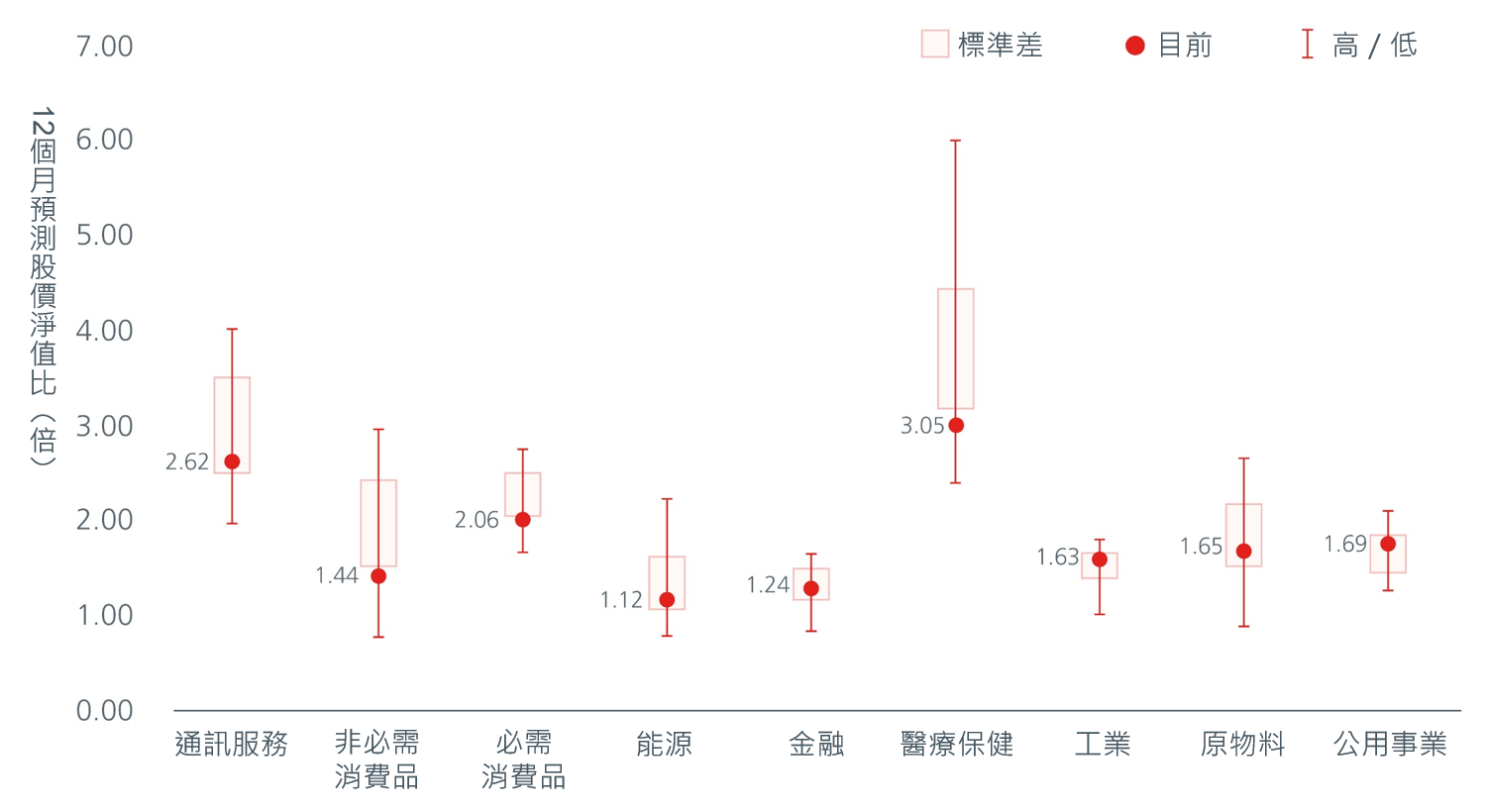
資料來源:Refinitiv Datastream的MSCI數據、麥格理及瀚亞投資,截至2021年7月31日。